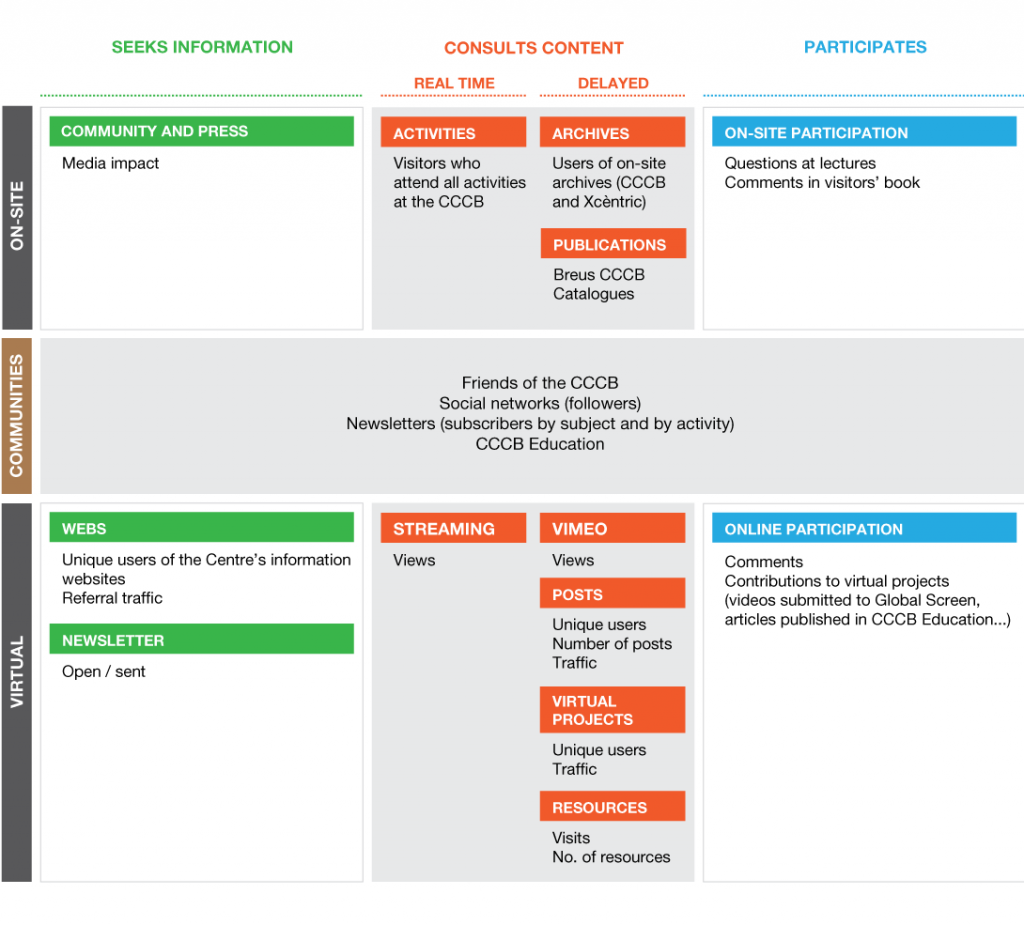
For quite some time, the “audience” of cultural centres has not been limited to the people who physically visit their premises. So-called “virtual audiences” – those who do not go to cultural centres but participate in their activities through the Internet – are taking on an increasingly important role. It is thus necessary to be aware of how these audiences behave, in order to understand their needs and plan projects that take their specific characteristics into account.
To begin with, when we talk about virtual audiences we are talking about a very heterogeneous group that uses different online channels to interact with cultural centres. In the CCCB’s case, these channels are the centre’s blogs and websites, social networks, and the online projects created for specific activities. In other words, the medium – the Internet – allows us to define the audience. But although we had used these channels as categories to differentiate between different online audiences, we are now finding that they are too broad and that they hinder a complex, overall analysis, or correlation with our on-site audiences.
We believe that it is important to understand the interaction between audiences and the CCCB, and to know what visitors look for in our online windows. In other words, the contents that audiences access, and the participatory dynamics that are generated, are more important than the channels that they use to access them. This approach has led us to identify three broad categories within the CCCB’s virtual audiences, according to how they behave: those who seek information, those who browse content, and those who actively participate. Given that on-site visitors engage in analogous behaviours, these categories offer us a joint, overall vision of two types of audiences that we have traditionally considered separately.
Information receivers
Generally speaking, information technologies initially entered cultural centres through their communication departments, and the CCCB is no exception. As a result, it’s hardly surprising that one of the basic functions of our online presence is to provide information about what goes on at the Centre. This early use of the Internet as a source of information and dissemination means that many of our virtual visitors use the Internet to find out about our activities, either through our websites, social networks, or electronic newsletters. But even though we refer to this group as an “audience”, we cannot count information receivers as part of our audience numbers, just as we don’t count somebody who comes into the CCCB reception area to pick up a bi-monthly programme, or somebody who reads an article about us in a newspaper. Nonetheless, it is important to analyse this group and take it into account when we work with communities – a concept that we will go into later – and plan communication, press and dissemination strategies.
Content browsers
As well as broadening the dissemination of our activities, the Internet also allows us to offer audiences additional content in the form of interviews, articles, photographs, videos, and so on. By creating and opening up their archives and broadcasting their activities, cultural institutions have contributed to the emergence of a virtual audience that consumes material that is produced by cultural centres and disseminated online: students, remote audiences, and people interested in specific subjects, for example, as well as people with special needs (such as reduced mobility or hearing), and others who simply prefer to access content online, if available. We consider this content to be the virtual part of our on-site activities, their expansion into the virtual sphere, and we need to be able to put the audiences of both spheres on the same level in order to understand the CCCB’s audience as a whole. For example, when we analyse the audience that attends a conference series, we should take into account those who follow the debates online – either live or on-demand – those who watch interviews with the speakers, and those who read the chronicles and conclusions in our blogs. If we can understand which audience groups consume our online content, we will be able to improve its creation and dissemination.
Active Participants
The Internet has enabled an unprecedented two-way relationship between institutions and audiences. The key idea here is not about participation for its own sake, but about setting up a high-quality relationship with our audiences so as to create a CCCB community and promote its loyalty through blogs, social networks, and other participation tools. This audience layer, which we can call contributors or “prosumers”, has an active approach – it doesn’t just consume content, it also participates by creating its own. At the CCCB, projects such as Global Screen and Brangulí Was Here. What about you? have proven the existence of a virtual audience that is willing to actively participate in contributing to our activities and enriching them with new points of view.
 Audience communities
Audience communities
Aside from these three audience categories, we are also interested in the concept of community. The Internet allows real-time interaction to coexist with asynchronous participation, and this extends the time and broadens the spaces in which the Centre engages with its audiences, as well as enhancing this relationship. All of this enables the creation of communities based on shared interests and characteristics. If the surest way for companies to promote customer loyalty is to build committed brand communities, in the field of cultural management communities can be the best way to detect, discover and consolidate new audiences.
These communities are not limited to the Centre’s programming, and tend to form around specific themes. This in turn makes it possible for the Centre to reflect and programme content around specific shared interests, to generate dialogue and discussions, to enable participation…. This dynamic also encourages the channelling of audiences between different activities that share points in common. This approach does not just strengthen the core themes that cultural centres work with, it also has an overall strengthening effect on both the virtual and the on-site spheres.
Although the CCCB has traditionally created communities through its projects (Xcèntric, Kosmopolis, CCCB Lab, Public Space…), it is worth noting that the ones that have survived and flourished are those that have sprung up around specific subjects: experimental film in the case of Xcèntric, literature in the case of Kosmopolis. By studying them and understanding their behaviour, we can learn to improve our interaction with them and offer them more appropriate content.
Getting to know virtual audiences
When we talk about audiences, we are talking about people. People that physically or virtually arrive at the CCCB. The difference between them is the way they behave once they are inside. On-site audiences also display the three types of behaviour mentioned above, but in this case the difference is even clearer: the three behaviours are often successive and clearly identifiable. On the other hand, the nature of the Internet means that the boundaries between categories tend to blur. Online channels can often be used in different ways, which makes the analysis of virtual audiences more complex and requires the use of specific tools to obtain accurate and reliable information. Given their importance and complexity, it is vital to analyse virtual audiences using reliable methods that make it possible to correct errors, make decisions based on objective data, and evaluate our online activity.
It is also important to recognise the reality of these new types of audiences, and to work towards integrating their expectations and needs when we design and plan our activities. In their approach to audiences, cultural centres like the CCCB need to integrate both on-site and virtual audiences. This will make it possible to move towards integrating virtual content and communities into the Centre’s physical spaces and media, and to open up to new programming models that equate virtual and on-site audiences.
Finally, it is important to pay attention to and promote the creation of communities based around the themes that the Centre works with. Building groups around a shared interest allows us to channel audiences between different activities that have a common theme, and helps us to build their loyalty.
It is often said that the online presence of cultural centres is not just a matter for the communication department, but an attitude that has to cut across the Centre as a whole. In this spirit, as cultural centres we have to recognise the existence of these new audiences, get to know them, and include them in our programming.
CCCBLab Team, Diffusion and External Resources Section.


Rosa | 14 November 2015
Superinteressant!
Equip CCCB LAB | 15 November 2015
Gràcies!
Leave a comment